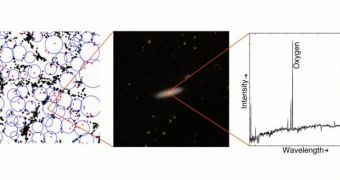Black holes have been known to exist in several environments, like in the center of most galaxies, including our own Milky Way, or created by the collapse of individual stars, and even produced after the collision of two galaxies. So far, little was known about another, stranger type of black hole, that lurks in the dark void between galaxies.
Now, a study done by astronomers from Drexel and Widener Universities, using data from the Sloan Digital Sky Survey (SDSS-II), announced that actively growing supermassive black holes in centers of galaxies are common even in cosmic voids, the most rarefied and empty regions of the universe.
These gigantic black holes have masses millions to hundreds of millions times that of our sun and, surprisingly, can even exist in regions of space where galaxies are sparse and have almost no interaction with each other. "The simple presence of growing supermassive black holes in the rural outposts of the universe challenges the current theoretical models of galaxy and structure formation and evolution", explained Anca Constantin of Drexel University, lead author of the paper delivered today at the American Astronomical Society meeting in Honolulu.
"Interestingly, we see actively accreting galactic black holes in all phases of evolution in these sparse regions," said Constantin. "This means that the black hole growth process is quite similar in what could be compared to the most reclusive countrysides and in the crowded urban regions of the universe."
Almost half of the Universe consists of nearly void regions of space, hundreds of millions of light-years across, where only about 5 percent of all the galaxies are found, the rest living together in communities, crowded into clusters, filaments, and walls: the cities and suburbs of the universe.
The scientists discovered the loneliest black holes in the Universe by studying the spectra of the centers of void galaxies showing hot gases ionized by light emitted from matter swirling around supermassive black holes. "The more isolated accreting black holes are however not as active as the ones in more populous environs, and the fuel seems less available for accretion in voids than in 'urban' galaxies," found Constantin.
Since the formation of stars requires the presence of large amounts of gas, the void galaxies must contain more than enough gas. The fact that the amounts of gas are not so high as in galaxy clusters leads to the life cycle of black hole growth in voids being delayed or slower compared to that in denser regions.

 14 DAY TRIAL //
14 DAY TRIAL //